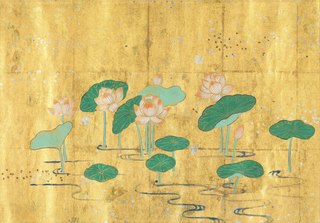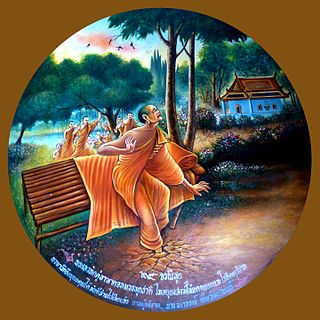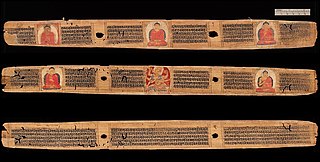Related Research Articles

Yama is the Hindu deity of death, dharma, the south direction, and the underworld. Belonging to an early stratum of Rigvedic Hindu deities, Yama is said to have been the first mortal who died in the Vedas. By virtue of precedence, he became the ruler of the departed.

Chinese Buddhism or Han Buddhism is a Chinese form of Mahayana Buddhism which draws on the Chinese Buddhist canon as well as numerous Chinese traditions. Chinese Buddhism focuses on studying Mahayana sutras and Mahāyāna treatises and draws its main doctrines from these sources. Some of the most important scriptures in Chinese Buddhism include: Lotus Sutra, Flower Ornament Sutra, Vimalakirtī Sutra, Nirvana Sutra, and Amitābha Sutra. Chinese Buddhism is the largest institutionalized religion in mainland China. Currently, there are an estimated 185 to 250 million Chinese Buddhists in the People's Republic of China. It is also a major religion in Taiwan, Singapore, and Malaysia, as well as among the Chinese Diaspora.

Dajian Huineng, also commonly known as the Sixth Patriarch or Sixth Ancestor of Chan, is a semi-legendary but central figure in the early history of Chinese Chan Buddhism. According to tradition he was an uneducated layman who suddenly attained awakening upon hearing the Diamond Sutra. Despite his lack of formal training, he demonstrated his understanding to the fifth patriarch, Daman Hongren, who then supposedly chose Huineng as his true successor instead of his publicly known selection of Yuquan Shenxiu.

The Mahāyāna sūtras are a broad genre of Buddhist scripture (sūtra) that are accepted as canonical and as buddhavacana in Mahāyāna Buddhism. They are largely preserved in Sanskrit manuscripts, and translations in the Tibetan Buddhist canon and Chinese Buddhist canon. Several hundred Mahāyāna sūtras survive in Sanskrit, or in Chinese and Tibetan translations. They are also sometimes called Vaipulya ("extensive") sūtras by earlier sources. The Buddhist scholar Asaṅga classified the Mahāyāna sūtras as part of the Bodhisattva Piṭaka, a collection of texts meant for bodhisattvas.

The Lotus Sūtra is one of the most influential and venerated Buddhist Mahāyāna sūtras. It is the main scripture on which the Tiantai, Tendai, Cheontae, and Nichiren schools of Buddhism were established. It is also influential for other East Asian Buddhist schools, such as Zen. According to the British Buddhologist Paul Williams, "For many Buddhists in East Asia since early times, the Lotus Sūtra contains the final teaching of Shakyamuni Buddha—complete and sufficient for salvation." The American Buddhologist Donald S. Lopez Jr. writes that the Lotus Sūtra "is arguably the most famous of all Buddhist texts," presenting "a radical re-vision of both the Buddhist path and of the person of the Buddha."

Hungry ghost is a term in Buddhism, and Chinese traditional religion, representing beings who are driven by intense emotional needs in an animalistic way. The terms 餓鬼èguǐ literally "hungry ghost", are the Chinese translation of the term preta in Buddhism and is a Sanskrit word. "Hungry ghosts" play a role in Chinese Buddhism and Taoism as well as in Chinese folk religion. The term is not to be confused with the generic term for "ghost" or damnation, 鬼guǐ. The understanding is that all people become such a regular ghost when they die, and would then slowly weaken and eventually die a second time.

The Ghost Festival or Hungry Ghost Festival, also known as the Zhongyuan Festival in Taoism and the Yulanpen Festival in Buddhism, is a traditional festival held in certain East and Southeast Asian countries. According to the Chinese calendar, the Ghost Festival is on the 15th night of the seventh month.

Devadatta was by tradition a Buddhist monk, cousin and brother-in-law of Gautama Siddhārtha. The accounts of his life vary greatly, but he is generally seen as an evil and divisive figure in Buddhism, who led a breakaway group in the earliest days of the religion.

Dharanis, also known as Parittas, are Buddhist chants, mnemonic codes, incantations, or recitations, usually the mantras consisting of Sanskrit or Pali phrases. Believed to be protective and with powers to generate merit for the Buddhist devotee, they constitute a major part of historic Buddhist literature. Many of these chants are in Sanskrit and Pali, written in scripts such as Siddhaṃ as well as transliterated into Chinese, Korean, Japanese, Vietnamese, Sinhala, Thai and other regional scripts. They are similar to and reflect a continuity of the Vedic chants and mantras.

Maudgalyāyana, also known as Mahāmaudgalyāyana or by his birth name Kolita, was one of the Buddha's closest disciples. Described as a contemporary of disciples such as Subhuti, Śāriputra, and Mahākāśyapa, he is considered the second of the Buddha's two foremost male disciples, together with Śāriputra. Traditional accounts relate that Maudgalyāyana and Śāriputra become spiritual wanderers in their youth. After having searched for spiritual truth for a while, they come into contact with the Buddhist teaching through verses that have become widely known in the Buddhist world. Eventually they meet the Buddha himself and ordain as monks under him. Maudgalyāyana attains enlightenment shortly after that.
Ekayāna is a Sanskrit word that means "one path" or "one vehicle". It is used in the Upanishads and the Mahāyāna sūtras.
In Buddhism, the eight precepts is a list of precepts that are observed by lay Buddhists on observance days and festivals. They include general precepts such as refraining from killing, but also more specific ones, such as abstaining from cosmetics and entertainments. This tradition of keeping the eight precepts on observance days are still widely practice in all Theravadin Buddhist countries and Theravadin Buddhist communities worldwide. Based on pre-Buddhist sāmaṇa practices, the eight precepts are often upheld on the Buddhist observance days, and in such context called the uposatha vows or one-day precepts. They are considered to support meditation practice, and are often observed when staying in monasteries and temples. In some periods and places the precepts were widely observed, such as in 7th–10th-century China by government officials. In modern times, there have been revival movements and important political figures that have observed them continuously.
Naraka is a term in Buddhist cosmology usually referred to in English as "hell" or "purgatory". The Narakas of Buddhism are closely related to Diyu, the hell in Chinese mythology. A Naraka differs from one concept of hell in Christianity in two respects: firstly, beings are not sent to Naraka as the result of a divine judgment or punishment; and secondly, the length of a being's stay in a Naraka is not eternal, though it is usually incomprehensibly long.

The Amitāyurdhyāna Sūtra (Sanskrit); simplified Chinese: 佛说观无量寿佛经; traditional Chinese: 佛說觀無量壽佛經; pinyin: Fóshuōguānwúliàngshòufójīng; Vietnamese: Phật Thuyết Kinh Quán Vô Lượng Thọ Phật; English: Sutra on the Visualization of [the Buddha] Immeasurable Life) is a Mahayana sutra in Pure Land Buddhism, a branch of Mahāyāna Buddhism.

Mahāyāna is a term for a broad group of Buddhist traditions, texts, philosophies, and practices developed in ancient India. It is considered one of the three main existing branches of Buddhism, the others being Theravāda and Vajrayāna. Mahāyāna accepts the main scriptures and teachings of early Buddhism but also recognizes various doctrines and texts that are not accepted by Theravada Buddhism as original. These include the Mahāyāna sūtras and their emphasis on the bodhisattva path and Prajñāpāramitā. Vajrayāna or Mantra traditions are a subset of Mahāyāna which makes use of numerous tantric methods Vajrayānists consider to help achieve Buddhahood.
Hongaku is an East Asian Buddhist doctrine often translated as "inherent", "innate", "intrinsic" or "original" enlightenment and is the view that all sentient beings already are enlightened or awakened in some way. It is closely tied with the concept of Buddha-nature.

Mulian Rescues His Mother or Mulian Saves His Mother From Hell is a popular Chinese Buddhist tale first attested in a Dunhuang manuscript dating to the early 9th century CE. It is an elaboration of the canonical Yulanpen Sutra which was translated from Indic sources by Dharmarakṣa sometime between 265 and 311 CE. Maudgalyayana, whose abbreviated Chinese transliteration is Mulian, seeks the help of the Buddha to rescue his mother, who has been reborn in the preta world or in the Avici Hell, the karmic retribution for her transgressions. Mulian cannot rescue her by his individual effort, however, but is instructed by the Buddha to offer food and gifts to monks and monasteries on the fifteenth day of the seventh lunar month, which established the Ghost Festival. While Mulian's devotion to his mother reassured East Asians that Buddhism did not undermine the Confucian value of filial piety and helped to make Buddhism into a Chinese religion, it also reflected strong undercurrents of filial piety that existed throughout Indian Buddhism as evidenced through its canonical texts and epigraphical remains.

Along With the Gods is a South Korean manhwa series written and illustrated by Joo Ho-min. The webtoon was released on Internet portal Naver WEBTOON since 2010, and the first volume in print was published on December 27, 2010. It was inspired by the Korean Joseon dynasty Buddhist paintings and early Buddhist texts of the Ten Kings of Hell. A manga adaptation was serialized in Young Gangan from 2012 to 2014 and was illustrated by Yoshiyuki Miwa; some scenes were changed due to the cultural differences between Japan and Korea. A staged musical adaptation has been hosted by the Seoul Performing Arts Company since 2015. A film adaptation, Along with the Gods: The Two Worlds, was released on December 20, 2017, with a sequel, Along with the Gods: The Last 49 Days, released on August 1, 2018. Two additional sequels are in active development as of September 2022, as well as a television series spin-off as of April 2022.

Filial piety has been an important aspect of Buddhist ethics since early Buddhism, and was essential in the apologetics and texts of Chinese Buddhism. In the Early Buddhist Texts such as the Nikāyas and Āgamas, filial piety is prescribed and practiced in three ways: to repay the gratitude toward one's parents; as a good karma or merit; and as a way to contribute to and sustain the social order. In Buddhist scriptures, narratives are given of the Buddha and his disciples practicing filial piety toward their parents, based on the qualities of gratitude and reciprocity. Initially, scholars of Buddhism like Kenneth Ch'en saw Buddhist teachings on filial piety as a distinct feature of Chinese Buddhism. Later scholarship, led by people such as John Strong and Gregory Schopen, has come to believe that filial piety was part of Buddhist doctrine since early times. Strong and Schopen have provided epigraphical and textual evidence to show that early Buddhist laypeople, monks and nuns often displayed strong devotion to their parents, concluding that filial piety was already an important part of the devotional life of early Buddhists.
Jacqueline Ilyse Stone is an emeritus professor of Japanese religion in the department of religion at Princeton University and a specialist in Japanese Buddhism, particularly Kamakura Buddhism, Nichiren Buddhism from medieval to modern times, and deathbed practices in Japan. Stone has been elected to the American Academy of Arts and Sciences.
References
- ↑ "Stephen F. Teiser". 22 August 2016.
- ↑ Stephen "Buzzy" Teiser Center on Contemporary China (Princeton University)
- ↑ Teiser (1988), p. xi-xii.
- ↑ Terry F Kleeman, "Review," The Journal of Asian Studies 49.1 (1990): 141-142. Quote from Teiser (1988) p. 42.
- ↑ B.J. Ter Haar, "Review", T'oung Pao (1993) p. 379
- 1 2 Kieschnick, John (2009), "(review)", Harvard Journal of Asiatic Studies, 69 (1): 234–239, doi:10.1353/jas.0.0013, S2CID 191151878 .
- ↑ Teiser, Stephen F. (1994). The Scripture on the Ten Kings and the Making of Purgatory in Medieval Chinese Buddhism. p. 3.
- ↑ Teiser, Stephen F. (1994). The Scripture on the Ten Kings and the Making of Purgatory in Medieval Chinese Buddhism. Honolulu: University of Hawaii Press. ISBN 0824815874. Book reviewed by The China Quarterly.